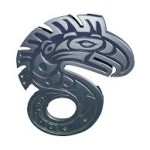
I’ve been active playing Shadowrun since 2003 in a group of people who have committed to that future world scenario RPG. Three of us are still there while four people have chosen to leave us on the way and three people have recently joined us. The player ages range from 23 to roughly 60 and we all enjoy the interesting and diversified gameplay that this pen & paper game provides.
Wikipedia says that Shadowrun is a science tabletop pen&paper game playing in the near future, but I don’t see science as a main driver for the gameplay. “Near future” means in our group that we are always set 70 years off from today as it was specified in the core rulebook in version 3 of the game when we started in 2003 (which was the current version then). In November 2013 the 5th version of the core rules was published bringing some slight improvements to the more complicated version 4 ruleset. The science part in Shadowrun is more a driver when it comes to the storyline that develops but you don’t need to be a tekkie to understand the important parts of the story (or to change the story in a relevant way).
The roleplaying game is played in the traditional way where there is one game master who is developing the story around the characters (at least one player has) created depending on the current set of rules the group has agreed on(V5 at the moment). Each character has a set of attributes and skills that define the set of possibilities the character has during the gameplay. These values are rounded off by a story about the history of the character that explains why that person is currently at that place in in this situation, in addition to some gear and a lifestyle.
Shadowrun gets another facet being open to the magic world and meta-human races of Orcs, Elves, Dwarfs and Trolls. The setting in 70 years time is quite hostile as politics and wars are being fought rather between corporations than countries, races and religions bring up new conflicts, and every person needs to care for her-/himself to stay alive. A (meta-)human live doesn’t count (cost) much and so corporations often rely on small private groups outside of their grounds and legislation to do their dirty work like killing someone (wetwork), kidnapping some important scientist (extraction) or simply sabotaging a site of another company, stealing their intellectual property. Corporations bring in the scientific aspect of the storyline, magicians and computerfreaks (running in the matrix of things) bring that freaky bit of the storyline that shadowrunners love so much.
I’ll give you a few examples here from time to time by updating you with our current storyline as played in our favorite local pub. As I’m mastering the group consisting of five players with a very heterogenious set of characters. We have two magicians and a technomancer (computer freak) who come from a corporate background and only run through the shadows to get some relief from the office life. They started off with a small run to get one of their buddies freed from a street clinic where he wanted to get some technical exchange body parts. As that small tour went well the security lead of their corporation decided to use the team as a undercover infiltration team to persue the corporate goals (and maybe some of his own). The were introduced into a team of urban brawl fighters to get a legal background for running in the shadows. Urban brawl is a very popular “sport” in Shadowrun where two teams fight with lethal weapons against each other while trying to score shooting a ball into the enimy’s goal. This is broadcast live through the future TV stations (Trideo). Playing in that urban brawl league two more players joined the shadowrun team from the other fighters.
This team of five currently has the objective to infiltrate the cottage of a very old elf in the Outer Hebrides and retrieve a collection of extremely powerful and invaluable magical artefacts and possibly dispose of the old Lady. The team does not yet know who and how they are going to fight against their enimies, but they are heavily armed and full of good spirit…

 The art of wargaming has evolved over the past fifty years and that is a good thing. I don’t mean to take away from the wonderful designs of the past, I myself am an avid collector and player of classic wargames. Designers have introduced new mechanics and modern elements to wargames; and I speak not just of
The art of wargaming has evolved over the past fifty years and that is a good thing. I don’t mean to take away from the wonderful designs of the past, I myself am an avid collector and player of classic wargames. Designers have introduced new mechanics and modern elements to wargames; and I speak not just of 